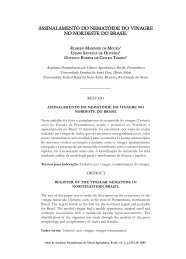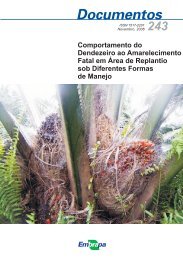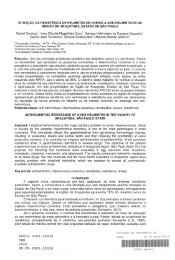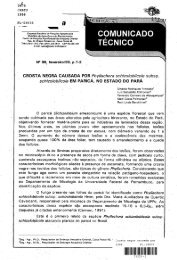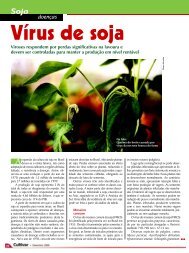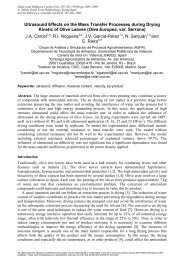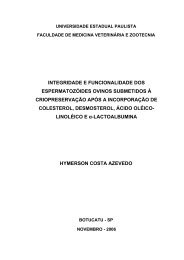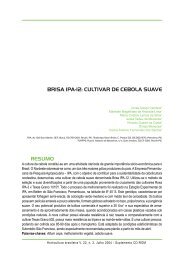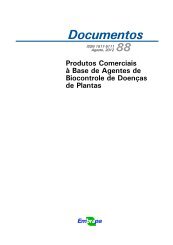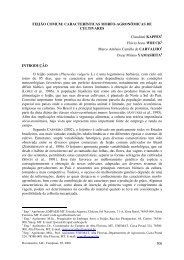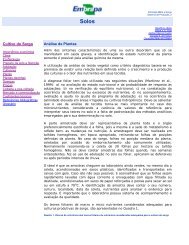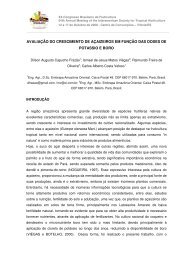Guarana´'s Journey from Regional Tonic to Aphrodisiac and ... - Ainfo
Guarana´'s Journey from Regional Tonic to Aphrodisiac and ... - Ainfo
Guarana´'s Journey from Regional Tonic to Aphrodisiac and ... - Ainfo
Create successful ePaper yourself
Turn your PDF publications into a flip-book with our unique Google optimized e-Paper software.
Advance Access Publication 5 December 2007 eCAM 2010;7(3)279–282<br />
doi:10.1093/ecam/nem162<br />
Review<br />
Guaraná’s <strong>Journey</strong> <strong>from</strong> <strong>Regional</strong> <strong>Tonic</strong> <strong>to</strong> <strong>Aphrodisiac</strong><br />
<strong>and</strong> Global Energy Drink<br />
Nigel Smith 1 <strong>and</strong> André Luiz Atroch 2<br />
1 Department of Geography, PO Box 117315, University of Florida, Gainesville, FL 32611-7315, USA <strong>and</strong><br />
2 EMBRAPA Amazônia Occidental, Manaus, Amazonas, Brazil<br />
Guarana´ (Paullinia cupana H.B.K., Sapindaceae) is a rainforest vine that was domesticated in<br />
the Amazon for its caffeine-rich fruits. Guarana´ has long been used as a <strong>to</strong>nic <strong>and</strong> <strong>to</strong> treat<br />
various disorders in Brazil <strong>and</strong> abroad <strong>and</strong> became a national soda in Brazil about a century<br />
ago. In the last two decades or so, guaraná has emerged as a key ingredient in various ‘sports’<br />
<strong>and</strong> energy drinks as well as concoctions that allegedly boost one’s libido. For some time,<br />
guarana´’s high caffeine content was thought <strong>to</strong> be a detriment because of health concerns about<br />
excessive intake of caffeine-rich drinks. But it is precisely this quality, <strong>and</strong> the fact that it has<br />
a mysterious name <strong>and</strong> comes <strong>from</strong> an exotic l<strong>and</strong>, that has propelled guaraná in<strong>to</strong> a global<br />
beverage.<br />
Keywords: Amazonia – aphrodisiac – ethnopharmacology – guaraná – medical his<strong>to</strong>ry – Paullinia<br />
cupana – xanthines<br />
Introduction<br />
Guarana´ seeds contain more caffeine than any other<br />
plant in the world with levels ranging <strong>from</strong> 2 <strong>to</strong> 7.5% (1).<br />
Guarana´ contains about four times as much caffeine as<br />
coffee. Some 60 plant species contain caffeine, including<br />
coffee, distributed among seven plant families. Guarana´<br />
seeds also contain traces of theobromine <strong>and</strong> theophylline,<br />
other alkaloids in the xanthine group (2). The<br />
evolutionary ‘purpose’ of the xanthines is unclear, but<br />
they may help protect the plants <strong>from</strong> attack by insect<br />
pests, herbivores <strong>and</strong> pathogens. In humans, xanthines<br />
stimulate the central nervous system, increase secretion of<br />
gastric acid <strong>and</strong> serve as a bronchodila<strong>to</strong>r <strong>and</strong> a diuretic.<br />
Caffeine is also addictive, although it is not classified<br />
as a ‘drug’ by government agencies charged with sorting<br />
out which plants <strong>and</strong> synthetic compounds are deemed<br />
a public menace. Ironically, guarana´’s high caffeine<br />
levels were once thought <strong>to</strong> be a detriment in promoting<br />
guaraná outside of Brazil because of health concerns<br />
For reprints <strong>and</strong> all correspondence: Prof. Nigel Smith, Department of<br />
Geography, PO Box 117315, University of Florida, Gainesville,<br />
FL 32611-7315, USA. E-mail: nsmith@geog.ufl.edu<br />
about excessive caffeine consumption, but now this attribute<br />
has turned out <strong>to</strong> be a marketing asset. This article<br />
traces how an ancient remedy for a variety of ailments<br />
has been dis<strong>to</strong>rted by market forces in<strong>to</strong> an aphrodisiac<br />
<strong>and</strong> energy booster, often concocted with ‘medicinal’<br />
herbs <strong>and</strong> vitamins.<br />
Origins <strong>and</strong> Early Medicinal Uses<br />
Guarana´ was domesticated in the interfluvial forests<br />
between the lower Tapajo´s <strong>and</strong> lower Madeira in the<br />
Brazilian Amazon. It is unclear which indigenous group<br />
domesticated guaraná, but the Sateré-Maué who live<br />
along the Maués River <strong>and</strong> its affluents cultivate guarana´<br />
extensively <strong>and</strong> have incorporated the plant in their<br />
mythology. A Satere´-Maue´ myth recounts how guarana´<br />
sprung <strong>from</strong> the eye of a boy who had been murdered<br />
(3); indeed guaraná fruit resembles an human eye when it<br />
ripens <strong>and</strong> the red skin <strong>and</strong> underlying white mesocarp<br />
split <strong>to</strong> reveal a black, iris-like seed.<br />
Guarana´ has long been esteemed for its energetic <strong>and</strong><br />
curative properties. In the late 17th century, for example,<br />
the Jesuit missionary João Felipe Betendorf noted that<br />
ß 2007 The Author(s).<br />
This is an Open Access article distributed under the terms of the Creative Commons Attribution Non-Commercial License (http://creativecommons.org/<br />
licenses/by-nc/2.0/uk/) which permits unrestricted non-commercial use, distribution, <strong>and</strong> reproduction in any medium, provided the original work is<br />
properly cited.
280 Guarana´—<strong>Regional</strong> <strong>to</strong> global<br />
the Sateré-Maue´ (then known as the Andirazes) valued<br />
guaraná as much as Europeans did gold because the<br />
drink gave them ‘so much energy, that when hunting,<br />
they could go <strong>from</strong> one day <strong>to</strong> the next without feeling<br />
hungry’ (4). Father Betendorf noted that guaraná was<br />
drunk <strong>to</strong> diminish fevers <strong>and</strong> cure headaches, <strong>and</strong> also<br />
served as a powerful diuretic. On the latter he remarked<br />
that ‘With respect <strong>to</strong> its reputation for provoking the<br />
need <strong>to</strong> urinate, I can personally testify.’<br />
During the colonial period, guaraná was sold variously<br />
as a fortifier, stimulant, <strong>to</strong>nic, antidote <strong>to</strong> fever, a preventive<br />
against hardening of the arteries <strong>and</strong> <strong>to</strong> treat<br />
migraines. Guarana´ was deemed especially effective in<br />
treating diarrhea <strong>and</strong> dysentery (5,6). But as with any<br />
product, overindulgence can trigger problems. Over two<br />
centuries ago, Francisco Xavier Ribeiro de Sampaio,<br />
a Brazilian judge, warned that excessive drinking of<br />
guaraná can lead <strong>to</strong> insomnia <strong>and</strong> even impotence (7).<br />
In the middle of the 18th century while visiting Santarém<br />
along the middle Amazon, the fourth Bishop of Bele´m,<br />
Dom Joa˜o de Sa˜o Jose´ de Queiro´s da Silveira greatly<br />
appreciated guarana´ but warned that excessive consumption<br />
could lead <strong>to</strong> insomnia or dizziness (8).<br />
Cultivation <strong>and</strong> Processing<br />
Guarana´ is grown on small <strong>and</strong> large farms, either as a<br />
monocrop or alongside other crops. Guarana´ is harvested<br />
by h<strong>and</strong> in the dry season. If the entire fruit bunch is<br />
ripe, it is either snipped off with scissors or small pruning<br />
shears, or broken off manually. If only a few berries are<br />
ripe, they are picked individually. The guaraná fruits<br />
are then placed in a basket <strong>and</strong> carried back <strong>to</strong> the home.<br />
Before roasting the seeds, the red skin must be removed.<br />
The fruits are skinned by h<strong>and</strong>, left <strong>to</strong> soak in water,<br />
or simply s<strong>to</strong>red for several days until the skin softens.<br />
On small farms in the Maue´s watershed, guaraná seeds<br />
are roasted on a griddle, preferably of clay <strong>to</strong> reduce the<br />
chances of burning. Clay griddles are about two meters<br />
in diameter <strong>and</strong> are made at various households along<br />
the Maue´s <strong>and</strong> some of its affluents, wherever suitable<br />
clay is found. Guarana´ seeds are roasted in an open-sided<br />
hut, but it is hot work <strong>and</strong> it takes several hours. Women<br />
roast guaraná in Satere´-Maue´ society; they periodically<br />
s<strong>to</strong>p stirring the seeds <strong>to</strong> pick some up <strong>and</strong> smell them <strong>to</strong><br />
see if they are ready <strong>to</strong> come off the griddle. The <strong>to</strong>asted<br />
seeds are then pounded in a wooden mortar, mixed with<br />
water <strong>and</strong> then molded in<strong>to</strong> cylinders (basta˜o) before<br />
drying in the sun. They are then smoked in specialized<br />
huts for several weeks <strong>to</strong> impart a unique flavor. The<br />
smoked cylinders last up <strong>to</strong> a year, whereas powdered<br />
guaraná loses some of its flavor after a few months (9).<br />
Industrial plants grind the roasted beans with machinery<br />
similar <strong>to</strong> that used for processing coffee.<br />
Evolution of Guaraná Beverages in Brazil<br />
To prepare the traditional guarana´ beverage, the hard<br />
cylinder is grated with the bony <strong>to</strong>ngue of the pirarucu<br />
(Arapaima gigas), one of the largest fish in the Amazon,<br />
or a small piece of flat rough s<strong>to</strong>ne, such as s<strong>and</strong>s<strong>to</strong>ne<br />
(10). The powder either collects on a piece of paper or<br />
falls directly in<strong>to</strong> a calabash gourd containing water. The<br />
Satere´-Maue´ call the tan-colored guarana´ drink çapo´ (11).<br />
In Sateré-Maue´ culture, only women prepare guarana´<br />
for drinking, whereas among non-indigenous folk, both<br />
men <strong>and</strong> women grate the cylinders. For more formal<br />
occasions, the Sateré-Maué use a small, hour glassshaped<br />
st<strong>and</strong> (patuai), fashioned <strong>from</strong> forest vines,<br />
<strong>to</strong> support the calabash bowl when grating guaraná.<br />
The host <strong>and</strong> guests then pass the bowl around <strong>and</strong><br />
periodically place it back on the st<strong>and</strong>. Urban <strong>and</strong> rural<br />
folk in the Maués watershed typically take guarana´ upon<br />
rising <strong>and</strong> wait an hour or two before a breakfast<br />
of black coffee <strong>and</strong> crackers or bread.<br />
Guarana´ was transformed <strong>from</strong> an elixir <strong>and</strong><br />
home-prepared beverage <strong>to</strong> a mass-produced soda<br />
in the early 20th century. The emergence of ice-making<br />
machines further propelled the soda industry in Brazil<br />
<strong>and</strong> elsewhere in the early 1900s. Sa˜o Paulo-based<br />
Antarctica that merged in 1999 with Brahma <strong>to</strong> form<br />
AmBev <strong>and</strong> was in turn purchased by InBev, a Belgian<br />
company, in 2003, introduced carbonated guarana´<br />
<strong>to</strong> Brazilians in 1909. At first, guaraná soda was sold<br />
mainly in southern Brazil, but many independent bottlers<br />
began making their own versions all over Brazil. In the<br />
Brazilian states of Amazonas <strong>and</strong> Bahia, guarana´<br />
pushups became popular among poorer folk in urban<br />
areas as soon as refrigeration became widespread in the<br />
mid-20th century known as dindin or chopp.<br />
Emergence of Guaraná as an <strong>Aphrodisiac</strong><br />
In the last decade or so, guarana´ carts have begun<br />
appearing in some street markets in the Brazilian<br />
Amazon, such as Bele´m, Abaetetuba, Manaus <strong>and</strong><br />
Manacapuru. Such carts sell guaraná beverages prepared<br />
in a blender with crushed ice. The formula for the energy<br />
drink varies among vendors, but generally contains nuts,<br />
such as cashew, peanuts or Brazil nuts, powdered milk,<br />
aphrodisiac roots or barks <strong>and</strong> guaraná powder or syrup.<br />
Some add fruit, such as avocado or raw quail eggs.<br />
Guarana´ smoothies prepared on ambulant carts as well<br />
as in some cafe´s in the Brazilian Amazon are uplifting<br />
<strong>and</strong> fulfilling, similar in texture <strong>and</strong> effect <strong>to</strong> a<br />
frappuccino served in espresso cafe´s in North America.<br />
One company has also employed guaraná in a<br />
concoction with ‘love herbs for good staying power’.<br />
It contains a ‘mixture of exotic South American<br />
herbs’, including damiana (Turnera diffusa Willdenow<br />
et Schultes; a Central American herb used <strong>to</strong> make
eCAM 2010;7(3) 281<br />
aphrodisiac beverages), schiz<strong>and</strong>ra (Schis<strong>and</strong>ra chinensis<br />
(Turcz.) Baill; a vine <strong>from</strong> northeastern China <strong>and</strong> Japan<br />
thought <strong>to</strong> have immune-enhancing properties), guaraná,<br />
<strong>and</strong> maté (Ilex paraguayensis A. St.-Hil.), a temperate<br />
<strong>to</strong> subtropical tree in South America with leaves used for<br />
making a tea (12).<br />
Energy Drinks <strong>and</strong> the Globalization<br />
of Guaraná<br />
Energy drinks, which often contain guaraná, have<br />
emerged as a boom sec<strong>to</strong>r in the global soda industry.<br />
The fact that the boom in guaraná-containing drinks has<br />
not spurred much increase in the area devoted <strong>to</strong> the crop<br />
is one indication that beverage manufacturers are being<br />
quite parsimonious in the amount of guaraná they are<br />
using in their products. The state of Amazonas in Brazil<br />
typically produces only 700–800 <strong>to</strong>ns of guarana´ seeds<br />
a year with little noticeable upward trend. The Brazilian<br />
Amazon is responsible for roughly a third of the guarana´<br />
produced in Brazil, so national production is less than<br />
three thous<strong>and</strong> <strong>to</strong>ns of dried guaraná seed a year. The<br />
globalization of guaraná beverages is thus not benefiting<br />
the Amazon much as has happened in the past with other<br />
booms, such as rubber extraction in the late 19th century<br />
<strong>and</strong> early 20th century.<br />
Dozens of new energy drinks containing guaraná<br />
are reaching the shelves of supermarkets, gas stations<br />
<strong>and</strong> convenience s<strong>to</strong>res every year. Both multinational<br />
corporations <strong>and</strong> small, independent companies have<br />
ventured in<strong>to</strong> the fray. Many of the names given the<br />
guaraná-containing beverages evoke energy. Indeed, the<br />
label on one drink claims that for indigenous peoples<br />
guaraná ‘was a primal source of energy <strong>from</strong> the Amazon<br />
jungle’.<br />
The formula of energy drinks with guaraná varies<br />
between product lines <strong>and</strong> even over time with the same<br />
product name, but usually contains one or more of the<br />
following plants: gingko biloba, ginseng, maté, Echinacea<br />
(taken by some in the belief that it prevents or reduces<br />
the severity of colds) <strong>and</strong> yohimbe (Pausinystalia yohimba<br />
Pierre ex Baille). Other ingredients range <strong>from</strong> bee pollen<br />
<strong>to</strong> fruit juices, arginine (a non-essential amino acid that<br />
allegedly boosts the immune system <strong>and</strong> promotes muscle<br />
growth), zinc <strong>and</strong> creatine (a dietary supplement taken by<br />
some <strong>to</strong> increase muscle mass).<br />
Medical Concerns<br />
The dramatic increase in beverages containing guarana´<br />
<strong>and</strong> other sources of caffeine has stirred some concern in<br />
the medical community. Already some young people have<br />
been admitted <strong>to</strong> emergency rooms suffering <strong>from</strong> overdoses<br />
of caffeine after overindulging. The increased<br />
consumption of caffeine beverages <strong>and</strong> pills is a symp<strong>to</strong>m<br />
of modern life which leaves insufficient time for a good<br />
night’s sleep. Moderate consumption of drinks containing<br />
caffeine might alleviate drowsiness for a while, but it<br />
cannot replace the need for sleep. Little evidence suggests<br />
that caffeine intake boosts performance in sports or in<br />
the bedroom. Proper hydration <strong>and</strong> adequate rest as well<br />
as paying attention <strong>to</strong> diet <strong>and</strong> regular exercise are likely<br />
<strong>to</strong> prove more helpful.<br />
Guarana´ is known <strong>to</strong> help stave off hunger <strong>and</strong> it is<br />
used by people trying <strong>to</strong> lose weight. But almost all<br />
energy drinks with guaraná as one of the ingredients<br />
also contain large amounts of high fruc<strong>to</strong>se corn syrup,<br />
a sure sign that the beverages are not particularly healthy<br />
<strong>and</strong> may lead <strong>to</strong> weight gain when taken on a regular<br />
basis. Only a few of the energy drinks containing guarana´<br />
have diet versions. Guarana´ powder contains negligible<br />
calories but is bitter. Most people who consume guarana´<br />
products outside of the traditional area of consumption<br />
are drinking highly sugared beverages. Improved eating<br />
habits <strong>and</strong> increased exercise as part of a transformed life<br />
style are better bets for keeping the weight off.<br />
Prospects for Guaraná<br />
Sales of products containing guarana´ are likely <strong>to</strong><br />
continue soaring in spite of some medical concerns.<br />
The stimulating effects of guaraná are longer lasting than<br />
coffee because the caffeine in guaraná apparently binds<br />
with tannins (16). Guarana´ also has the luster of an<br />
exotic rainforest vine with a long his<strong>to</strong>ry of use as a<br />
medicinal plant. Curiously, guaraná was consumed in the<br />
United States <strong>and</strong> Europe in the 18th <strong>and</strong> 19th century,<br />
<strong>and</strong> then dropped <strong>from</strong> the pharmacopeias in those<br />
regions until the late 20th century when it re-emerged in<br />
carbonated energy drinks, aphrodisiac concoctions <strong>and</strong><br />
stay alert pills. The success of such guarana´ products<br />
may provide momentum for soda manufacturers <strong>to</strong><br />
launch guarana´ soda in industrial nations, perhaps with<br />
a stronger concentration of syrup typical of the robust<br />
sodas produced by local companies in Manaus, Brazil.<br />
References<br />
1. Beck HT. Caffeine, alcohol, <strong>and</strong> sweeteners. In: Prance GT (ed).<br />
The Cultural His<strong>to</strong>ry of Plants. New York: Routledge, 2005, 173–90.<br />
2. Pizza C, Rastrelli L, Totaro K, De Simone F. Paullinia cupana<br />
(guarana´) determinazione degli alcaloidi xantinici per la valutazione<br />
della qualita´ di prodotti base di guarana´. In: Il Guarana´ degli Indios<br />
Satere´-Maue´, Istitu<strong>to</strong> Italo-Latinoamericana, Rome: Serie Scienza<br />
13, 1999, 13–22.<br />
3. Pereira N. Os Ińdios Maue´s. Organizac¸a˜o Simo˜es, Rio de Janeiro,<br />
1954.<br />
4. Betendorf JF. Chronica da missa˜o dos padres da Companhia<br />
de Jesus no Estado do Maranhão. Revista do Institu<strong>to</strong> His<strong>to</strong>rico<br />
e Geographico Brazileiro 1909;72:1–682.<br />
5. Steinen, K von den. Durch Central-Brasilien: Expedition zur<br />
Erforschung des Shingu´ im Jahre 1884. Brockhaus, Liepzig, 1886.<br />
6. Castelnau, F. E´xpedition dans les Parties Centrales de l’Ame´rique<br />
du Sud, de Rio de Janeiro à Lima, et de Lima au Pará, pendant les<br />
Anne´es 1843–1847. Vol. 2, Paris: Bertr<strong>and</strong>, 1850.
282 Guarana´—<strong>Regional</strong> <strong>to</strong> global<br />
7. Sampaio, FXR. Dia´rio da Viagem que em Visita, e Correic¸ão, das<br />
Povac¸o˜es da Capitania de S. Joze do Rio Negro fez o Ouvidor,<br />
e Intendente Geral da Mesma, no Anno de 1774 e 1775. Lisbon:<br />
Typographia da Academia, 1825.<br />
8. Queiro´s da Silveira J. Viagem e visita do serta˜o em o Bispado<br />
do Gram-Para´ em 1762 e 1763. Revista Trimensal de His<strong>to</strong>´ria<br />
e Geografia 1847;9:43–527.<br />
9. Henman AR. Guarana´ (Paullinia cupana var. sorbilis): ecological<br />
<strong>and</strong> social perspectives on an economic plant of the central Amazon<br />
basin. J Ethnopharmacol 1982;6:311–38.<br />
10. Leacock S. Economic life of the Maué Indians. Boletim do Museu<br />
Paraense Emilio Goeldi (Nova Se´rie, Antropologia) 1964;19:1–30.<br />
11. Monteiro MY. Antropogeografia do Guarana´. Institu<strong>to</strong> Nacional de<br />
Pesquisas da Amazoˆnia, Cadernos da Amazoˆnia, No. 6, Manaus,<br />
1965.<br />
12. Tremble, Coca-Cola, tremble. The Economist, March 24, 2001,<br />
p. 35.<br />
13. www.ampenergy.com<br />
14. www.rockstar69.com/ingredients.html<br />
15. www.sobenofear.com/huh/nofear.shtml<br />
16. Ra¨tsch C. The Encyclopedia of Psychoative Plants: Ethnopharmacology<br />
<strong>and</strong> its Applications. Rochester, Vermont: Park Street Press, 2005.<br />
Received May 13, 2007; accepted September 12, 2007



